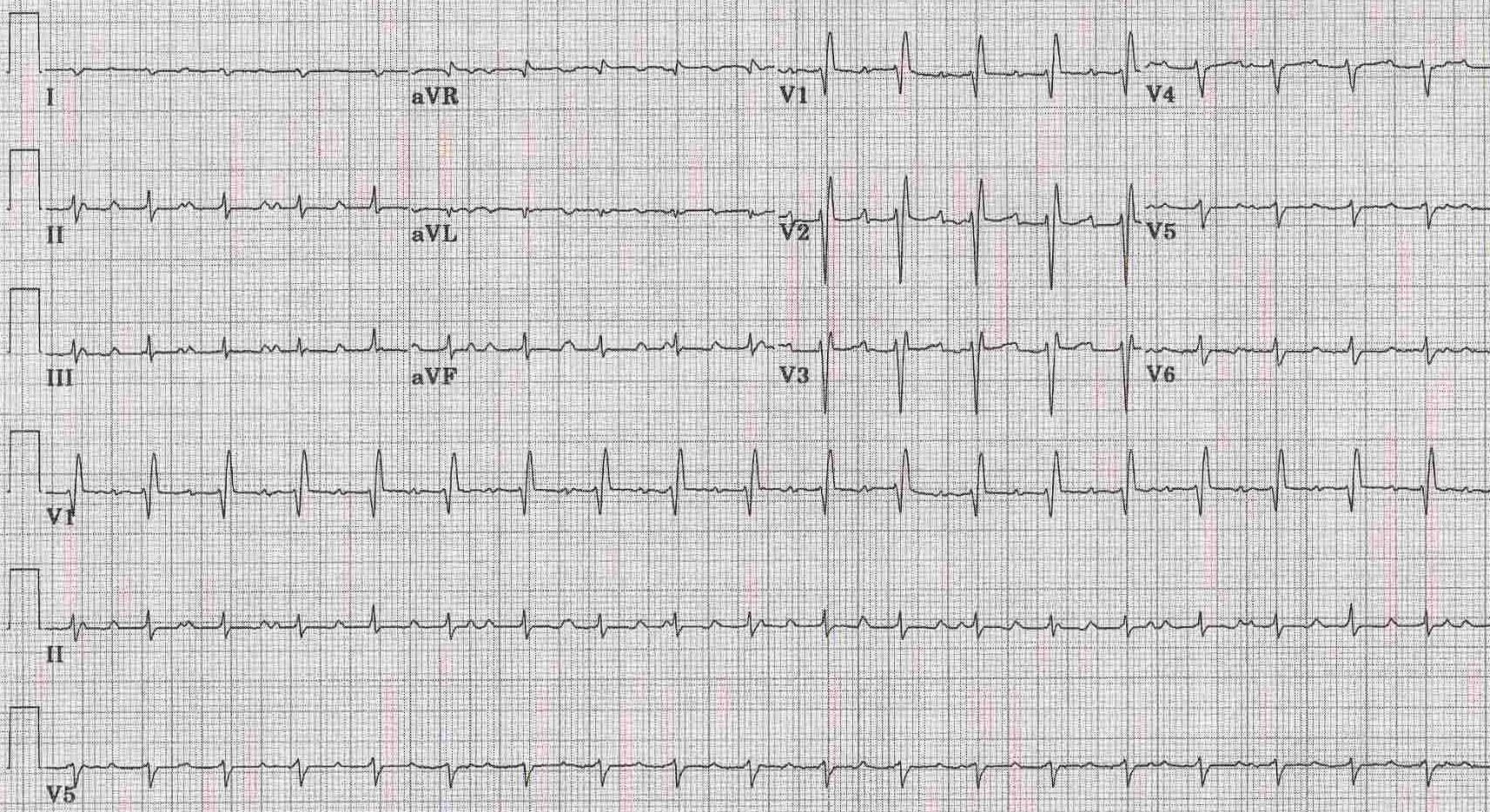Heart transplantation electrocardiogram and pacing after cardiac transplantation
|
Heart transplantation Microchapters |
|
Diagnosis |
|---|
|
Treatment |
|
Heart transplantation electrocardiogram and pacing after cardiac transplantation On the Web |
|
American Roentgen Ray Society Images of Heart transplantation electrocardiogram and pacing after cardiac transplantation |
|
FDA on Heart transplantation electrocardiogram and pacing after cardiac transplantation |
|
CDC onHeart transplantation electrocardiogram and pacing after cardiac transplantation |
|
Heart transplantation electrocardiogram and pacing after cardiac transplantation in the news |
|
Blogs on Heart transplantation electrocardiogram and pacing after cardiac transplantation |
Editor-In-Chief: C. Michael Gibson, M.S., M.D. [1]; Associate Editor-In-Chief: Cafer Zorkun, M.D., Ph.D. [2]
EKG Findings Following Transplantation
Shown below is an EKG showing accessory atrial activity (better seen in lead II at the end of the first complex in the middle between the second and third complex and after the third complex) due to some of the original sinus node still remains in addition to the donor sinus node after a cardiac transplant. Because of a suture line in the right atrium the ectopic atrial rhythm rarely conducts to the AV node. Right axis deviation and a rSR' which might suggest volume overload RVH also shown.

2012 ACC/AHA/HRS Guidelines for Device-Based Therapy of Cardiac Rhythm Abnormalities (DO NOT EDIT) [1] [2][3][4]
Pacing After Cardiac Transplantation (DO NOT EDIT)[4]
| Class I |
| "1. Permanent pacing is indicated for persistent inappropriate or symptomatic bradycardia not expected to resolve and for other Class I indications for permanent pacing. (Level of Evidence: C)" |
| Class IIb |
| "1. Permanent pacing may be considered when relative bradycardia is prolonged or recurrent, which limits rehabilitation or discharge after postoperative recovery from cardiac transplantation. (Level of Evidence: C)" |
| "2. Permanent pacing may be considered for syncope after cardiac transplantation even when bradyarrhythmia has not been documented. (Level of Evidence: C)" |
Sources
- 2012 ACCF/AHA/HRS Focused Update of the 2008 Guidelines for Device-Based Therapy of Cardiac Rhythm Abnormalities[3]
- The ACC/AHA/HRS 2008 Guidelines for Device-Based Therapy of Cardiac Rhythm Abnormalities [4]
References
- ↑ Tracy CM, Epstein AE, Darbar D, Dimarco JP, Dunbar SB, Estes NA; et al. (2012). "2012 ACCF/AHA/HRS focused update of the 2008 guidelines for device-based therapy of cardiac rhythm abnormalities: a report of the American College of Cardiology Foundation/American Heart Association Task Force on Practice Guidelines". J Am Coll Cardiol. 60 (14): 1297–313. doi:10.1016/j.jacc.2012.07.009. PMID 22975230.
- ↑ Chen JC, Lin LM, Geist JR, Chen JY, Chen CH, Chen YK (2013). "A retrospective comparison of the location and diameter of the inferior alveolar canal at the mental foramen and length of the anterior loop between American and Taiwanese cohorts using CBCT". Surg Radiol Anat. 35 (1): 11–8. doi:10.1007/s00276-012-0986-z. PMID 22669484.
- ↑ Epstein AE, DiMarco JP, Ellenbogen KA, Estes NA, Freedman RA, Gettes LS, Gillinov AM, Gregoratos G, Hammill SC, Hayes DL, Hlatky MA, Newby LK, Page RL, Schoenfeld MH, Silka MJ, Stevenson LW, Sweeney MO, Tracy CM, Epstein AE, Darbar D, DiMarco JP, Dunbar SB, Estes NA, Ferguson TB, Hammill SC, Karasik PE, Link MS, Marine JE, Schoenfeld MH, Shanker AJ, Silka MJ, Stevenson LW, Stevenson WG, Varosy PD (2013). "2012 ACCF/AHA/HRS focused update incorporated into the ACCF/AHA/HRS 2008 guidelines for device-based therapy of cardiac rhythm abnormalities: a report of the American College of Cardiology Foundation/American Heart Association Task Force on Practice Guidelines and the Heart Rhythm Society". J. Am. Coll. Cardiol. 61 (3): e6–75. doi:10.1016/j.jacc.2012.11.007. PMID 23265327.
- ↑ 4.0 4.1 4.2 Epstein AE, DiMarco JP, Ellenbogen KA, Estes NAM III, Freedman RA, Gettes LS, Gillinov AM, Gregoratos G, Hammill SC, Hayes DL, Hlatky MA, Newby LK, Page RL, Schoenfeld MH, Silka MJ, Stevenson LW, Sweeney MO. ACC/AHA/HRS 2008 guidelines for device-based therapy of cardiac rhythm abnormalities: executive summary: a report of the American College of Cardiology/American Heart Association Task Force on Practice Guidelines (Writing Committee to Revise the ACC/AHA/NASPE 2002 Guideline Update for Implantation of Cardiac Pacemakers and Antiarrhythmia Devices). Circulation. 2008; 117: 2820–2840. PMID 18483207